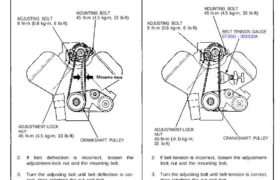Alternator Belt Adjustment
Deflection Method:
1. Apply a force of 100 N (10kg, 22 Ibs) between the
alternator and crankshaft pulley, and measure its
deflection.
Deflection: 11-13.5 mm (0.43-0.53 in)
NOTE: On a brand-new belt, the deflection should
be 6-8 mm (0.24-0.31 in) before the belt has
had any running time on the engine.
ADJUSTING BOLT
8 N-m (0.8 kg-m, 6 Ib-ft)
MOUNTING BOLT
45 N-m (4.5 kg-m, 33 Ib-ft)
ADJUSTMENT-LOCK
NUT
45 N-m (4.5 kg-m, 33 Ib-ft)
CRANKSHAFT PULLEY
2. If belt deflection is incorrect, loosen the
adjustment-lock nut and the mounting bolt.
3. Turn the adjusting bolt until belt deflection is cor-
rect, then retighten the nut and bolt.
4. Recheck the belt tension.
Tension Gauge Method:
1. Attach the belt tension gauge to the belt and
measure belt tension.
Tension: 450-650 N (45-65 kg, 99-143 Ibs)
NOTE: On a brand-new belt, the tension should be
900-1100 N (90-110 kg, 198-243 Ibs) before
the belt has had any running time on the engine.
MOUNTING BOLT
45 N-m (4.5 kg-m, 33 Ib-ft)
ADJUSTING BOLT
8 N-m (0.8 kg-m, 6 Ib-ft)
BELT TENSION GAUGE
07JGG – 001010A
ADJUSTMENT-LOCK
NUT
45 N-m (4.5 kg-m,
33 Ib-ft)
CRANKSHAFT PULLEY
2. If belt tension is incorrect, loosen the adjustment-
lock nut and the mounting bolt.
3. Turn the adjusting bolt until belt tension is correct,
then retighten the nut and bolt.
4. Recheck the belt tension.
Deflection Method:
1. Apply a force of 100 N (10kg, 22 Ibs) between the
alternator and crankshaft pulley, and measure its
deflection.
Deflection: 11-13.5 mm (0.43-0.53 in)
NOTE: On a brand-new belt, the deflection should
be 6-8 mm (0.24-0.31 in) before the belt has
had any running time on the engine.
ADJUSTING BOLT
8 N-m (0.8 kg-m, 6 Ib-ft)
MOUNTING BOLT
45 N-m (4.5 kg-m, 33 Ib-ft)
ADJUSTMENT-LOCK
NUT
45 N-m (4.5 kg-m, 33 Ib-ft)
CRANKSHAFT PULLEY
2. If belt deflection is incorrect, loosen the
adjustment-lock nut and the mounting bolt.
3. Turn the adjusting bolt until belt deflection is cor-
rect, then retighten the nut and bolt.
4. Recheck the belt tension.
Tension Gauge Method:
1. Attach the belt tension gauge to the belt and
measure belt tension.
Tension: 450-650 N (45-65 kg, 99-143 Ibs)
NOTE: On a brand-new belt, the tension should be
900-1100 N (90-110 kg, 198-243 Ibs) before
the belt has had any running time on the engine.
MOUNTING BOLT
45 N-m (4.5 kg-m, 33 Ib-ft)
ADJUSTING BOLT
8 N-m (0.8 kg-m, 6 Ib-ft)
BELT TENSION GAUGE
07JGG – 001010A
ADJUSTMENT-LOCK
NUT
45 N-m (4.5 kg-m,
33 Ib-ft)
CRANKSHAFT PULLEY
2. If belt tension is incorrect, loosen the adjustment-
lock nut and the mounting bolt.
3. Turn the adjusting bolt until belt tension is correct,
then retighten the nut and bolt.
4. Recheck the belt tension.
